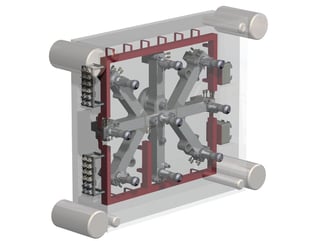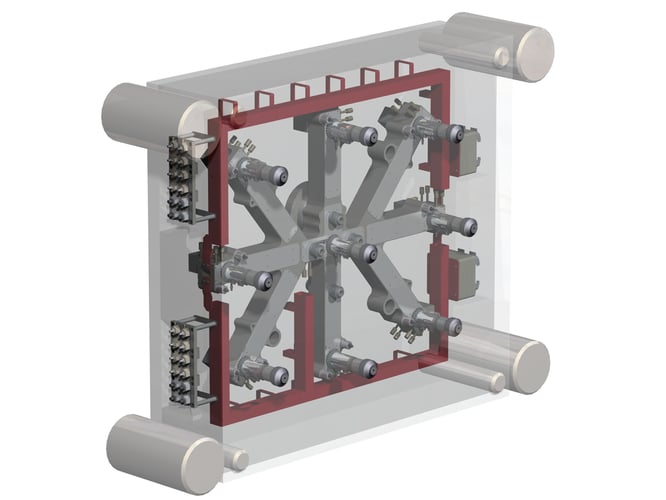
One of the first places to look when you are troubleshooting an injection molding process is the hot runner system. Whether the mold is a cold runner or a hot runner, the influence it can have on the part you ship to your customer can be the difference between success and failure. Profit or loss.
In a previous life, I was asked to take a look at a process that was producing a kick panel (or shark fin) for an automotive interior part supplier. It was a LH/RH 1+1 cold runner mold, running PP. They were scrapping an excessive amount of parts for splay on the A-surface.
Picking up the next shot that came down the conveyor belt, I looked at the grained side of each cavity. The defect was fairly obvious on the RH cavity (the operator still was glad to point it out for me). It looked like splay (silver streak) an inch or so from the edge of the part. I was fairly certain that it wasn’t moisture splay, as PP is non-hygroscopic.
I immediately flipped the part over to look for a potential cause on the B-side. Clip towers, locators and other B-side geometry are often contributors to visual defects on the A-surface. But nothing on the back looked like it was the cause of the blemish. The blemish was near the gate, about an inch away in the direction of flow. I pulled a runner from the scrap box that had come down the belt with the parts. The sprue bushing end of the runner was clean with what looked to be a 3/16” orifice at the start of the runner (small slug pulled out of the nozzle tip was just under 3/16” showed that the nozzle tip was sized correctly) tapering out to approximately ½” at the sprue puller/cold slug well. The runner split into two beams, with each supplying a single cashew/sub gate. Just after the cashew was an ample cold slug well. Just before the start of the cashew, there was a puller/ejector pin.
And there it was.
At the end of the puller, on the side of the runner that supplies the RH part, was an ugly, frayed, pulled, and stretched piece of flash. I grabbed a handful of runners from the scrap box. They all had the flash.
We interrupted the cycle to take a look at the mold. On the moving side (ejector side) of the mold, at the puller/ejector pin on the RH cavity side of the runner, was an equally ugly, frayed, pulled piece of plastic hanging on the ejector pin. There’s the problem, the culprit, the root cause, the red X.
The piece of flash that was left dangling on the ejector pin after the parts were ejected from the mold was being forced into the cavity during the next shot. It would end up on the A-surface and appear as splay. The technicians had been trying to process the splay off with injection velocity but only succeeded in moving it around.
The machine was shut down. The tool room was called. The flash was a result of wear on the ejector pin. The temporary fix was to grind additional stock off of the pin. This resulted in a heavier, toenail-like flash on the runner puller. This flash stayed on the runner during ejection and left no remnants in the mold. The parts no longer had the defect. Life is good. We’re making money again.
At the end of the production run, the mold was pulled. Repairs were made to the thru hole and the ejector pin was replaced with a properly sized pin.
There are other problems that can be revealed by inspecting the runner.
- Under or oversized nozzle tip orifice.
- Incorrect nozzle tip radius.
- Injection unit out of alignment.
- Insufficient cold slug wells.
- Sharp edges or runner shut-offs out of position.
- Gates not separating from part properly.
These and other issues can result in finished part appearance defects such as dark streaks, shear splay, cold slugs, etc.
So remember, you may not ship the runners to your customer, but they have a huge influence on the parts you do.







Comments